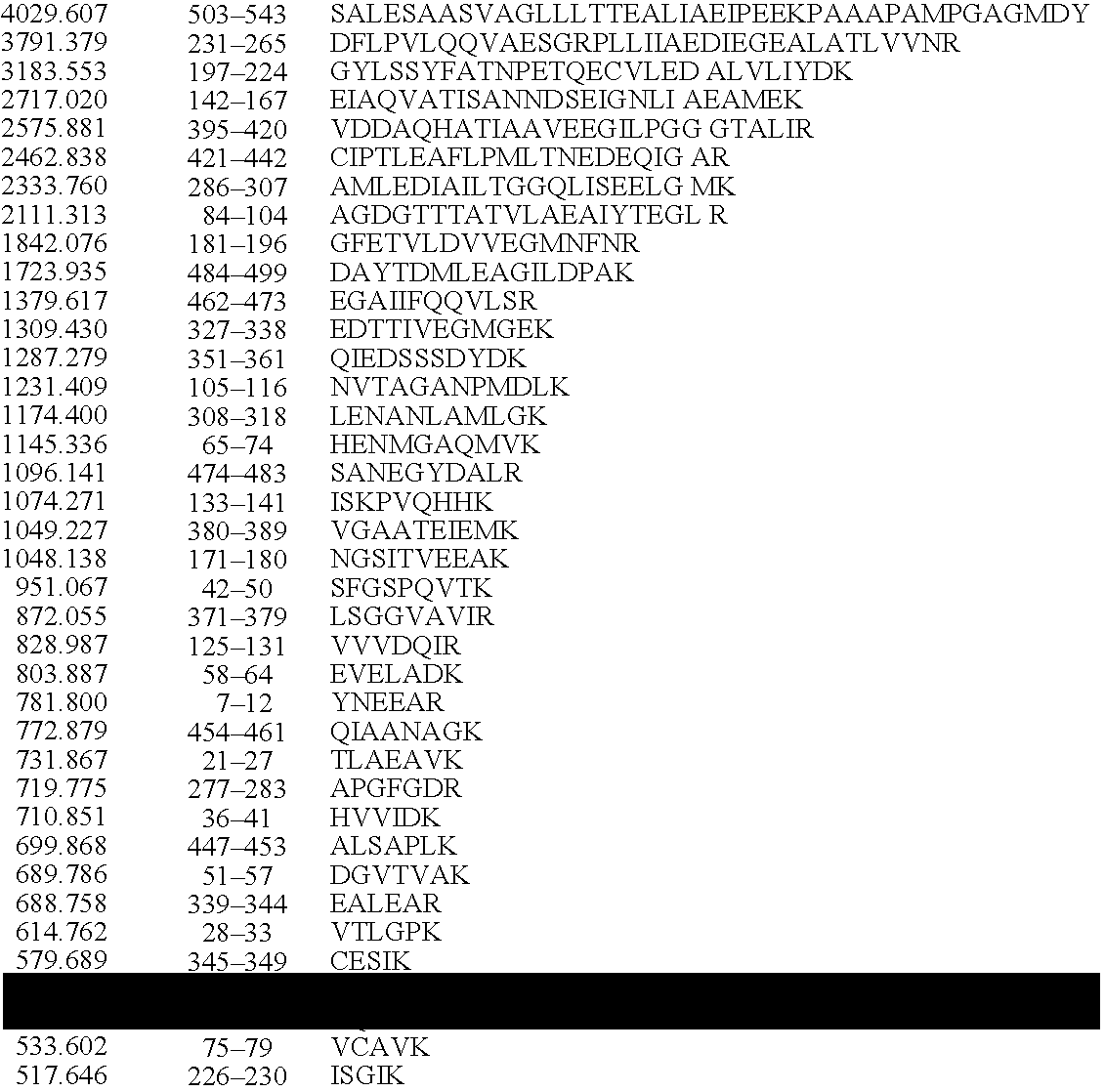Identifying micro-organisms
a microorganism and identification technology, applied in the field of identification of microorganisms, to achieve the effects of reducing the complication of enzyme molecules, and ensuring the accuracy of the identification process
- Summary
- Abstract
- Description
- Claims
- Application Information
AI Technical Summary
Benefits of technology
Problems solved by technology
Method used
Image
Examples
example 2
The use of Hsp60 as a Biomarker to Identify Potentially Pathogenic Bacteria
[0060] The average molecular mass of Hsp60 from a wide variety of organisms may be both predicted to a high degree of accuracy from the known amino acid sequence (corrected for mixture of isotopes present) and directly measured using the appropriate purified recombinant protein. Although Hsp60 is highly conserved across many species, not just bacteria, mass spectrometry allows highly accurate determination of mass and allows proteins molecules differing by as little as three mass units to be distinguished. Comparison of such measured values with a database of known values allows identification of the species involved, as shown in Table 1.
1 TABLE 1 Hsp60 M.sub.r Bacterium 58015.3 Da Chlamydia trachomatis 57301.7 Da Francisella tularensis 57154.8 Da Salmonella typhimurium 56757.3 Da Burkholderia pseudomallei
[0061] FIG. 2 shows a graphical comparison the Hsp60 masses of a wider range of organisms illustrating th...
example 3
Hsp60 Peptide Maps Derived from Hsp60 by Trypsin Digestion
[0065] As illustrated in Tables 2 and 3 above, enzymatic digestion of closely related Hsp60 proteins of similar overall molecular mass yields distinctive patterns of peptides that may be resolved by mass spectrometry. Trypsin cleaves peptides at the carboxy-peptide link of arginine and lysine residues (except where the next residue is a proline). Allowing for a mass accuracy of 0.01%, a few peptides are too similar to distinguish (boxed). In other cases, some very short peptides share identical composition and so have identical masses, and single free amino acids result from the cleavages. Even allowing for this, each peptide set constitutes a unique fingerprint, diagnostic of a specific organism from which the protein is derived.
example 4
Comparison of Arg-C Hsp60 peptides from Brucella Abortus and Staphylococcus Epidernidis
[0066] The endopeptidase Arg-C (clostripain), as its name suggests, cleaves the carboxy-peptide bonds of arginine. FIG. 4 shows a graphical comparison of the peptide fingerprints obtained from Arg-C digestion of Hsp60 from B. abortus and S. epidermidis. As shown in FIG. 3, the masses of the whole Hsp60 proteins from these organisms are similar (57649 and 57529, respectively including N-terminal methionines). However, the peptide sets obtained are quite distinct and characteristic of the organisms involved .
PUM
| Property | Measurement | Unit |
|---|---|---|
| concentration | aaaaa | aaaaa |
| concentration | aaaaa | aaaaa |
| volume | aaaaa | aaaaa |
Abstract
Description
Claims
Application Information
 Login to View More
Login to View More - R&D
- Intellectual Property
- Life Sciences
- Materials
- Tech Scout
- Unparalleled Data Quality
- Higher Quality Content
- 60% Fewer Hallucinations
Browse by: Latest US Patents, China's latest patents, Technical Efficacy Thesaurus, Application Domain, Technology Topic, Popular Technical Reports.
© 2025 PatSnap. All rights reserved.Legal|Privacy policy|Modern Slavery Act Transparency Statement|Sitemap|About US| Contact US: help@patsnap.com



